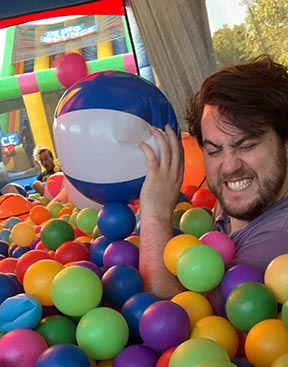The Quest to Dynamicize Metasurface Holography
Daniel Webb
Graduate Student
Applied Physics & Nano Technology
The Catholic University of America
Wed, November 10, 2021 - 4:00 PM
Karl Herzfeld Auditorium of Hannan Hall - Rm 108
 In the late 1940s, in attempts to better the resolution of electron microscopes, the concept of recording an interference pattern to reproduce a 3D field was invented. Unfortunately , the progression of this was stymied by the lack of coherent light sources available at the time. It wasn’t until the 1960s that the laser was invented, allowing the realization of holography. Arguably, it wasn’t until 1977, communicating a plea for help from Obi-Wan Kenobi, that an exciting trajectory for holography had been laid out. Still, technology of the time held back the actualization of 3D dynamic color holograms. It wasn’t until 2012 that a form of dynamic holography was presented, most famously, as Tupac Shakur’s posthumous performance at Coachella. These are examples of real object recording and replayed, but what about creating new images and scenes without needing to physically record the interference patterns? This is where we get in to Computer Generated Holography. Numerous algorithms have been developed to calculate the required amplitude or phase shifts of pixels to create an interference pattern for a computer image. What was traditionally displayed using spatial light modulators with the pixel pitch on the order of microns, the desire to reduce the size and increase resolution has led to an interest in 2D materials, or metamaterials. With the increase in capabilities and techniques of nanofabrication, groups have been able to create nanometer scale pixel pitch materials that have high resolution and can handle multiple colors by using nanoresonators in an array that can modulate a wavefront to produce a precalculated interference pattern. But now how do we make the image move? In this talk, I will cover the basics of computer generated holography and Metasurface designs that can produce a hologram. I will also discuss current and ongoing efforts in dynamic Metasurface holography.
In the late 1940s, in attempts to better the resolution of electron microscopes, the concept of recording an interference pattern to reproduce a 3D field was invented. Unfortunately , the progression of this was stymied by the lack of coherent light sources available at the time. It wasn’t until the 1960s that the laser was invented, allowing the realization of holography. Arguably, it wasn’t until 1977, communicating a plea for help from Obi-Wan Kenobi, that an exciting trajectory for holography had been laid out. Still, technology of the time held back the actualization of 3D dynamic color holograms. It wasn’t until 2012 that a form of dynamic holography was presented, most famously, as Tupac Shakur’s posthumous performance at Coachella. These are examples of real object recording and replayed, but what about creating new images and scenes without needing to physically record the interference patterns? This is where we get in to Computer Generated Holography. Numerous algorithms have been developed to calculate the required amplitude or phase shifts of pixels to create an interference pattern for a computer image. What was traditionally displayed using spatial light modulators with the pixel pitch on the order of microns, the desire to reduce the size and increase resolution has led to an interest in 2D materials, or metamaterials. With the increase in capabilities and techniques of nanofabrication, groups have been able to create nanometer scale pixel pitch materials that have high resolution and can handle multiple colors by using nanoresonators in an array that can modulate a wavefront to produce a precalculated interference pattern. But now how do we make the image move? In this talk, I will cover the basics of computer generated holography and Metasurface designs that can produce a hologram. I will also discuss current and ongoing efforts in dynamic Metasurface holography.
If you have any questions about the Colloquium Series or would like to make a donation please contact the Physics Department, cua-physics@cua.edu or (202) 319-5315.
